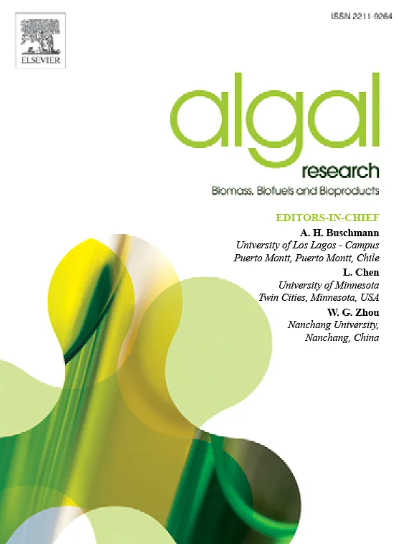Nannochloropsis for the bioremediation of brewery side streams and co-production of aquaculture feed and bio-Fertiliser: A comprehensive review
IF 4.6
2区 生物学
Q1 BIOTECHNOLOGY & APPLIED MICROBIOLOGY
Algal Research-Biomass Biofuels and Bioproducts
Pub Date : 2025-05-05
DOI:10.1016/j.algal.2025.104079
引用次数: 0
Abstract
The brewing industry produces a large amount nutrient-rich wastewater. This review proposes a framework that harnesses autotrophic microalgae to establish a circular brewing industry. The study focuses on Nannochloropsis due to their high omega-3 polyunsaturated lipids and protein content, enabling the upcycling of brewery wastewater into aquaculture feed and biofertiliser. In the proposed system, Nannochloropsis is cultivated on brewery wastewater under mixotrophic conditions, and the resultant biomass is used as a fishmeal replacement or biofertiliser. This approach reduces chemical and energy demands for brewery wastewater treatment, while also alleviating aquaculture's reliance on fishmeal derived from unsustainable wild-caught fishing and agriculture's dependence on carbon-intensive mineral fertilisers. A summary of the research to-date on the cultivation of microalgae on brewery wastewater, the use of brewer's spent grain as widely available and inexpensive carbon for microalgal fermentation, the application of Nannochloropsis in aquaculture and bio-fertiliser, and techno-economic and life-cycle assessments of the proposed system are provided. A mass balance of the system suggests that for every 1000 L of brewery wastewater that is treated, 1.0–1.4 kg of Nannochloropsis biomass can be produced, enabling the removal of 95–100 % of N and P and 60–90 % COD reduction from the wastewater and the direct capture of 0.7–1.3 kg of CO₂, while producing 0.4–0.8 kg of lipids for aquafeed formulations and 0.6–1.0 kg of biomass residue for biofertilisers. An integrated approach that combines laboratory research with pilot-scale validation and iterative techno-economic assessments is needed to inform optimisation and guide scale-up.

纳米叶绿体在啤酒厂边溪生物修复及水产养殖饲料和生物肥料联合生产中的应用综述
酿酒业产生大量富含营养的废水。本文提出了利用自养微藻建立循环酿酒产业的框架。该研究的重点是纳米绿藻,因为它们具有高的omega-3多不饱和脂质和蛋白质含量,可以将啤酒废水升级为水产养殖饲料和生物肥料。在该系统中,在混合营养条件下在啤酒废水上培养纳米绿藻,所得生物质用作鱼粉替代品或生物肥料。这种方法减少了啤酒废水处理的化学和能源需求,同时也减轻了水产养殖对不可持续的野生捕捞所得鱼粉的依赖,以及农业对碳密集型矿物肥料的依赖。本文综述了国内外在啤酒废水中培养微藻、利用啤酒废粮作为廉价碳源进行微藻发酵、纳米绿藻在水产养殖和生物肥料中的应用以及该系统的技术经济和生命周期评价等方面的研究进展。系统的质量平衡表明,每处理1000 L的啤酒废水,可以产生1.0-1.4 kg的纳米绿藻生物量,使废水中的N和P去除率达到95 - 100%,COD降低60 - 90%,直接捕获0.7-1.3 kg的CO₂,同时产生0.4-0.8 kg的饲料脂质和0.6-1.0 kg的生物肥料生物质残渣。需要一种将实验室研究与中试规模验证和迭代技术经济评估相结合的综合方法,以便为优化提供信息并指导扩大规模。
本文章由计算机程序翻译,如有差异,请以英文原文为准。
求助全文
约1分钟内获得全文
求助全文
来源期刊

Algal Research-Biomass Biofuels and Bioproducts
BIOTECHNOLOGY & APPLIED MICROBIOLOGY-
CiteScore
9.40
自引率
7.80%
发文量
332
期刊介绍:
Algal Research is an international phycology journal covering all areas of emerging technologies in algae biology, biomass production, cultivation, harvesting, extraction, bioproducts, biorefinery, engineering, and econometrics. Algae is defined to include cyanobacteria, microalgae, and protists and symbionts of interest in biotechnology. The journal publishes original research and reviews for the following scope: algal biology, including but not exclusive to: phylogeny, biodiversity, molecular traits, metabolic regulation, and genetic engineering, algal cultivation, e.g. phototrophic systems, heterotrophic systems, and mixotrophic systems, algal harvesting and extraction systems, biotechnology to convert algal biomass and components into biofuels and bioproducts, e.g., nutraceuticals, pharmaceuticals, animal feed, plastics, etc. algal products and their economic assessment
 求助内容:
求助内容: 应助结果提醒方式:
应助结果提醒方式:


